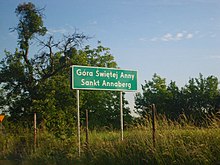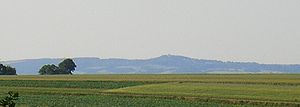Sankt Annaberg
| Sankt Annaberg | ||
|---|---|---|

|
|
|
| Basic data | ||
| State : | Poland | |
| Voivodeship : | Opole | |
| Powiat : | Strzelce Opolskie | |
| Gmina : | Leschnitz | |
| Geographic location : | 50 ° 27 ' N , 18 ° 10' E | |
| Residents : | 580 | |
| Postal code : | 47-150 | |
| Telephone code : | (+48) 77 | |
| License plate : | EAST | |
| Economy and Transport | ||
| Street : | A4 Opole - Katowice | |
| Next international airport : | Katowice | |
| administration | ||
| Sołtys : | Piotr Górecki | |
| Website : | gsa.lesnica.pl | |
Sankt Annaberg (also Annaberg ; Polish Góra Świętej Anny , Schlonsakisch Anaberg ) is a village in the bilingual town-and-country municipality of Leschnitz (Leśnica) in the Polish Voivodeship of Opole . The village with around 550 inhabitants is known for the monastery of the same name with a pilgrimage church on the Annaberg .
geography
About 10 kilometers southwest of the district town of Strzelce Opolskie (Groß Strehlitz) and 25 km southeast of Opole , Sankt Annaberg has a slip road to the A4 motorway . The development of the village adjoins the street village Wyssoka to the south and extends on the slopes of the 406 meter high Annaberg .
history
See also St. Annaberg
The history of the village is closely connected to the Inselberg rising from the plain , which served cultic purposes from an early age. On this Chelmberg , as the Annaberg was originally called, a church was built in an exposed location between 1480 and 1485 , the wooden statue of Anna herself soon became a destination for pilgrims. The village became Bohemian in 1327 and fell to Habsburg in 1635 . Melchior Ferdinand von Gaschin appointed Franciscans (OFM) to the Chelmberg in 1655, where they built a monastery and later a Calvary .
Annaberg, meanwhile the most important place of pilgrimage in Upper Silesia , was assigned to Prussian in 1742 and to the district of Groß Strehlitz in 1816. Felix Triest described the place as a “market town” in 1861, at that time Annaberg had 641 inhabitants who were mainly active in the handicrafts favored by the numerous pilgrims. The completely Catholic population was parish in Leschnitz .
In the referendum on March 20, 1921, 403 eligible voters voted to remain with Germany and 91 for Poland. Annaberg remained with the Weimar Republic . In the wake of the referendum, there was an open battle between Polish and German units on Annaberg from May 21 to 27, 1921, the climax of which was the storming of Annaberg by a free corps called "Upper Silesian Self-Protection" and the occupation of the mountain on May 21, 1921 . The uprising itself ended on July 5, 1921 with an armistice agreement that came about under pressure from the Allies (see uprisings in Upper Silesia ).
The rural community Annaberg belonged to the district Wyssoka, which was renamed "Annaberg" in 1933 under the new National Socialist rulers. A year later, on July 18, 1934, the name was changed to "Sankt Annaberg", whereupon in 1941 the name was again changed to the more secular "Annaberg OS". As early as 1939, the former seat of the administrative district, the Wyssoka renamed "Hohenkirch", was incorporated into the municipality of St. Annaberg. In 1940 the German authorities set up a forced labor camp . It served to expand the planned RAB 29 Reichsautobahn from Breslau to Katowice.
In 1945 the place fell to Poland and from then on bore the Polish name Góra Świętej Anny as the official place name. It remained the destination of many pilgrims. In 1950 the place came to the Opole Voivodeship, in 1999 to the restored powiat Strzelecki . In 1983 Pope John Paul II and Cardinal Joseph Ratzinger visited the pilgrimage site.
In 2006 the municipality of Leschnitz , to which the town of Sankt Annaberg belongs, introduced German as an auxiliary language and in 2008 a bilingual place name.
Population development
The population of Sankt Annaberg according to the respective territorial status:
|
|
Attractions
- The basilica is a Gothic-Baroque place of worship. It dates from around 1480 and was expanded after 1665 by the von Gaschin family. It was rebuilt in 1781 and received its tower in 1853.
- The Paradise Plaza is the courtyard outside the entrance to the basilica. The square is surrounded on three sides by cloisters. The cloisters date from 1768 and were rebuilt in 1804.
- Miraculous image of St. Anna Selbdritt . Work of art made of wood from the Middle Ages.
- Three Brothers Chapel (St. Annaberg)
- Lourdes Grotto and Way of the Cross , built from limestone between 1912 and 1914 based on the model of the Grotto of Lourdes in France, to commemorate the apparition of Mary there. The grotto also has an altar so that church services can be held in the open air. There is also a large square in front of the grotto, which is surrounded by the stations of the cross.
- Franciscan monastery , built between 1730 and 1749 and rebuilt in 1905.
- Pilgrims' home, built between 1929 and 1938
- Kalvarienweg with chapels (Kalvarienberg) from the 18th century.
- Nepomuk sculpture
- Open air theater from the 1930s
- Memorial to the memory of the uprisings
- 19th century lime kiln
Sons and daughters of the place
- Berthold Altaner (1885–1964), Catholic church historian and patrologist
- Reinhold Olesch (1910–1990), Slavist (including the vocabulary of St. Annaberg)
Web links
literature
- Góra Świętej Anny - Sanctuary Diecezji Opolskiej , 1985
Individual evidence
- ↑ RADA SOŁECKA / GRUPA ODNOWY. (No longer available online.) In: The site's website. Archived from the original on January 3, 2014 ; Retrieved January 3, 2014 (Polish). Info: The archive link was inserted automatically and has not yet been checked. Please check the original and archive link according to the instructions and then remove this notice.
- ↑ Cf. Felix Triest: Topographisches Handbuch von Oberschlesien. Wroclaw 1865
- ↑ See territorial.de ; down. on April 5, 2008
- ↑ Places of Martyrology - Annaberg Forced Labor Camp ( Memento of the original from January 31, 2017 in the Internet Archive ) Info: The archive link has been inserted automatically and has not yet been checked. Please check the original and archive link according to the instructions and then remove this notice. , sztetl.org.pl/de
- ↑ Sources of population figures :









